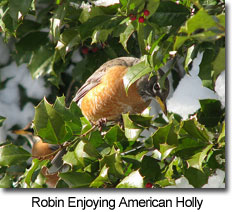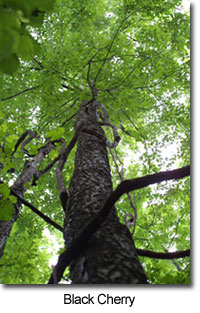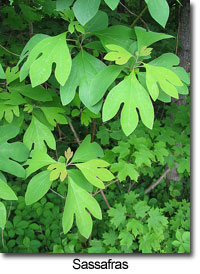How Often Does a Blue Spruce Bloom in Maryland
Creating a Wild Backyard - Native Maryland Trees
Main_Content
Trees and forests are prime habitat for many kinds of animals. Copse supply animals with food, nest materials, nest sites and shelter from weather and predators. Fruits, nuts, bawl, twigs and sap are all foods offered past trees. Birds, squirrels and other animals tin can find a identify to raise their young in trees that take hollow spaces in them. Trees can also shelter a variety of insect species that provide nutrient for small mammals and birds. Trees also provide shade for wildlife, other plants and people!
Types of Trees
Trees tin can exist divided into two main categories: those that lose their leaves and those that keep them year round. Trees that lose their leaves each year are known every bit deciduous trees. Trees that go along their leaves year round are known as evergreens. Many copse that produce cones (conifers) are evergreens while many flowering plants are deciduous.
Evergreens
Because evergreens keep their leafage or needles twelvemonth round, they are a dandy addition to your Wild backyard. Evergreens provide year round comprehend in addition to winter shelter and nesting sites. Evergreens also provide sap, cones, seeds, needles, twigs and bud throughout the year, creating a continuous food source. The following list contains several evergreens which are great for wildlife. Hyperlinks are provided for species with additional fact sheets.

American Holly
(Ilex opaca)American hollies grow from 15-50 feet tall and produce crimson, fleshy berries that are available throughout the winter. Birds are the principal consumers of American holly fruit, although deer, squirrels and other pocket-sized animals eat them. At least eighteen species of birds, including songbirds, Mourning Doves, wild turkeys and Northern Bobwhite Quails, are known to eat the fruit.
Arborvitae
(Thuja occidentalis)Arborvitae, also known as Northern white cedars are tall, cylindrical trees. Their dumbo foliage provides excellent cover year round for wildlife. Species such every bit songbirds, waterfowl and small mammals all benefit from Arborvitae. This tree grows best in wet, calcareous (calcium-rich) soils.
Eastern Scarlet Cedar
(Juniperus virginiana)Eastern cherry cedars can abound in whatsoever region of Maryland and are plant in dry-moist soils. This tree has calibration-like leaves and produces blue-green berries from July-March. Many birds and small mammals consume the berrylike cones of eastern cherry cedar, especially in wintertime. Wild animals species that eat eastern cherry-red cedar fruits include Cedar Waxwings, Bobwhite Quail, Ruffed Bickering, Ring-necked Pheasant, wild turkeys, rabbits, foxes, raccoons, skunks, opossums and coyotes.

Sweetbay Magnolia
(Magnolia virginiana)Sweetbay vegetation is used by a variety of wild animals species. Squirrels, other small-scale mammals, song birds wild turkeys and Bobwhite Quail feed on sweetbay seeds. Deer browse sweetbay leaves and twigs throughout the year. Sweetbay leaves are too used in nest structure by several bird species such as Eastern Kingbirds, Northern Mockingbirds, American Robins, Woods Thrushes and Scarlet-eyed Vireos.
Pines
(Pinus spp.)Pino copse are fast growing trees that provide tremendous wildlife benefits. Songbirds and small mammals do good the nigh from pine trees. Pino cones are a great food source year circular.
Deciduous Trees
Although deciduous trees lose their leaves in the fall and winter, they still provide comprehend and food important for wildlife. Leaf litter from deciduous trees also provides food and cover for many invertebrate species. Maryland has a greater diversity of deciduous trees, and many deciduous trees produce flowers and fruit beneficial for wildlife. The following listing contains deciduous trees that can enhance your backyard habitat. Hyperlinks are provided for species with additional fact sheets.
American Beech
(Fagus grandifolia)American beech trees are one native deciduous tree which can tolerate shade. Planting this tree in a shady backyard will provide nuts for songbirds and squirrels, sap for Yellow-bellied Sapsuckers and buds for finches.

Black Blood-red
(Prun united states of america serotina)The black blood-red can grow to 50 or lx feet tall. Many birds and small mammals eat black cherries. It is the preferred fruit of birds similar American Robins and Northern Mockingbirds. Black cherry sap is a favorite of the Yellow-bellied Sapsucker, a type of woodpecker. The Tiger Swallowtail besides uses Black Cherry-red as a larval host plant.
Hickory
(Automobile ya sp.)The almost common hickory species is the bitternut hickory. Songbirds such as grosbeaks, some woodpeckers, and other animals similar fox, squirrels and chipmunks consume hickory nuts. Shagbark hickory, which has shaggy, plated bawl too provides encompass for roosting bats.
Maple
(Acer sp.)Maples as well have winged seeds which are eaten by cardinals, evening grosbeaks, bobwhite quail, and other animals. Grosbeaks and American Goldfinches utilize the leaves for nesting textile and as well use the branches for supporting their nests. Maple sap is eaten by squirrels and songbirds and the sugar maple, establish in western and primal Maryland, provides sap for maple syrup.
Oaks
(Querc us sp.)

There are five types of oaks native to Maryland: the black, white, scarlet, red and pin oaks. Many songbirds, ducks, and other animals eat the acorns. Squirrels are famous for hiding acorns to get ready for the long wintertime. Deer consume oak leaves and twigs. Oaks provide branches for bird nests and hollows for woodpeckers, squirrels and other animals to raise their young in wooded protection. The leaves and branches provide shade and protection from the atmospheric condition.
Sassafras
(Sassafras albidum)The sassafras tree is common along fencerows, roadsides and abandoned fields. It is non oftentimes used by birds for nesting but its bluish fruits are a favorite of Gray Catbirds, American Robins and Eastern Bluebirds. In the fall, sassafras trees are in cute colour with orange leaves, blue fruits and greenish stems. The Spicebush Swallowtail besides uses Sassafras as a larval host plant.
Tulip Poplar
(Liriodendron tulipifera)

The tulip poplar is a fast-growing, alpine North American hardwood tree that can reach a height of over 150 feet! Hummingbirds enjoy its nectar, while Yellow-bellied Sapsuckers bask its sap. Tulip poplars produce seeds, which are favorites of Northern Cardinals. Hollow spaces inside this tree provide homes for squirrels and raccoons, among other animals.
White Ash (Fraxin us americana)
The white ash grows in moist soils and can grow from 50-100 feet. It is the most mutual of the ash species, while the green ash (Fraxinus pennsylvanica) is the most widespread. Yous will know the ash past its winged seeds which are consumed by many bird species. The seeds are favorites of Evening Grosbeaks and Purple Finches and are as well eaten by Northern Cardinals, Northern Bobwhite Quail and Wood Ducks.
Tips for Using Copse to Attract Wild animals
- Plant a diverseness of tree species
- Try to conform trees and shrubs in groups together or in hedgerows
- Avoid planting copse and shrubs in isolation from other vegetation, following your garden center's advice on how far apart your trees should be planted
- Attempt to plant some copse that grow tall and some that are not so tall, some that have bushy crowns with relatively blank trunks and some that have thick leaves and branches from the ground upward
- Wildlife species and insects sometimes will use special food and shelter sources found only in certain parts of trees. Planting trees with vertical variety increases your chances of having a greater variety of species on your holding.
- Be sure to plant some evergreens. For wildlife, evergreens provide shelter all year long, particularly in winter when other trees have lost their leaves.
- Remember that trees take time to grow. Fast growing species include sumac, cerise maple, alder and white pino. Consider the time information technology will take your trees to grow when preparing your afforestation plans.
- If you do not have mature trees nearby, nest boxes for birds and other wildlife can help provide shelter for those species, which use hollows or cavities in trees for nesting.
How to Establish a Tree
- Remove all wires, ropes, or burlap surrounding the roots of the tree.
- Dig a hole five times the diameter of the root ball, but approximately the same depth of the root ball.
- Set the tree in the centre of the planting area so that the upper surface of the root ball is level with the surrounding soil.
- Make full the pigsty with soil.
- Information technology is preferable non to stake or wrap the tree to stabilize it.
- Utilize water to pack or settle the soil effectually the root brawl and apply a two to four inch layer of mulch over the unabridged planting area.
For Boosted Information on Copse:
Visit DNR's Forest Service webpage or bank check out tree fact sheets provided past Virginia Tech.
Or, contact your State Project Forester or the Annapolis Office of the Forestry Service
410-260-8531 (Toll-gratis in Maryland: 1-877-620-8DNR, ext. 8531).
Invite Wild animals to Your Backyard!
For Additional Data, Contact:
Kerry Wixted
Wildlife and Heritage Service
580 Taylor Ave, E-i
Annapolis, Md 21401
kerry.wixted@maryland.gov
Phone: 410-260-8566
Fax: 410-260-8596
Acknowledgements:
- Black Ruddy Tree Photo courtesy of (c) 2002 Steven J. Baskauf, Bioimages home
- All other photographs by Kerry Wixted
Center_Content
Source: https://dnr.maryland.gov/wildlife/Pages/habitat/wamdtrees.aspx
0 Response to "How Often Does a Blue Spruce Bloom in Maryland"
Post a Comment